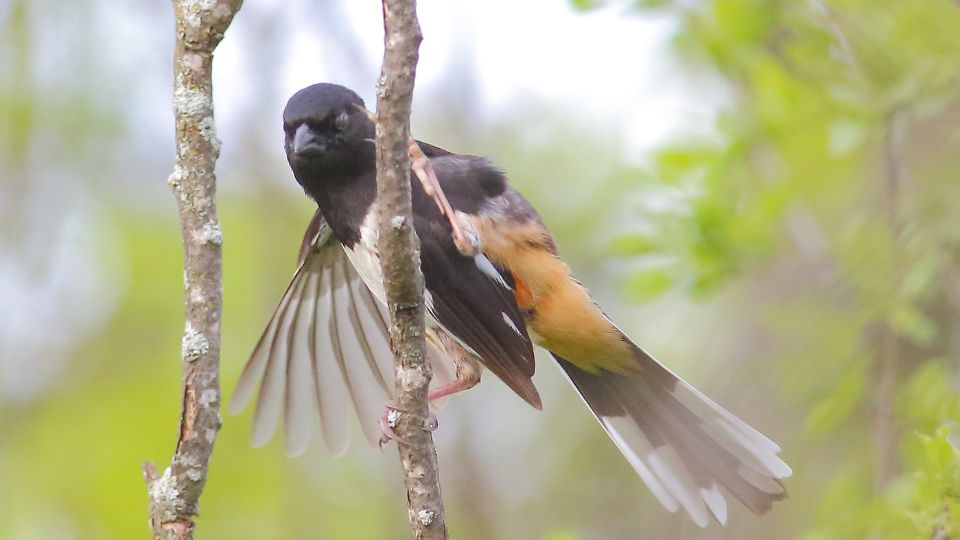The Eastern towhee call is bright and energetic and sounds like it’s saying drink-your-tea with a long trill at the end. In addition to Eastern Towhee songs, they also have a few unique chewink calls that they make when alarmed or communicating with other Towhees.
If you hear a bright and cheery drink-you-tea call outside your window, it’s likely an Eastern towhee. Their bird songs are filled with lively energy, and you will likely hear an Eastern towhee songbird before actually spotting one on a neighboring branch in the breeding months.
The Eastern Towhee’s Song
The Eastern Towhee (aka Pipilo erythrophthalmus) song sounds like it’s saying ‘drink-you-tea.’ The “drink” note is acute and grating, and the final “tea” note sounds like musical ripple. Sometimes the song does use the first note several times before leading into the rest of the call.
Towhee’s are known for having an energetic and lively call, with its faint metallic quality; it sounds similar to the fee-bee call of a chickadee. During the off-season, Eastern towhees are very secretive birds and spend most of their time foraging for food in the base of thickets and bushes. However, when mating season rolls around, the male Eastern towhee flies to the branches of a nearby tree to proudly sing its drink-your-tear melody to defend its territory.
Unlike other songbirds, the birdsong of the Eastern towhee isn’t explicitly designed to attract a mate. When you hear the call of an Eastern towhee, it’s a way of telling nearby Eastern towhee to steer clear of their territory. To attract a mate, the male towhee engages in a very muted version of its drink-your-tea song, accompanied by chasing down a female and rapidly fluttering its feathers.
What Do Towhee Calls Mean?
There are three distinct calls that Eastern Towhees make: songs, contact calls, and alarm calls. Their songs have a unique and cheery musical quality, while alarm calls and contact calls are short and abbreviated. Let’s break down some of their distinctive calls to understand what these backyard birds are saying.
The Typical Towhee Song
The typical Eastern towhee call is a sign that spring has sprung! During breeding, males perch nearby branches and sing their drink-your-tea melody. The song lasts only one second, and there is often a long pause between musical numbers. The music of the migratory Eastern towhee begins in the breeding season and lasts through late summer. Depending on where you are in the eastern United States, the beginning of breeding seasons varies slightly.
The breeding season kicks off as early as March in warmer parts of the country, such as Florida and Georgia. However, the farther you travel north, the later the breeding season starts. In parts of New England, and in places such as New York, you may not hear the cheery song of the Easter towhee until the middle of May.

Eastern Towhee Contact Calls
The call notes of the Eastern towhee contact calls vary depending upon the circumstance. To stay in contact with one another, they make a hoarse lisping call or a whistling chewink or joree call. These bird calls are a way for fellow towhees to stay in contact with each other and are often heard when traveling groups of towhee forage for food or hunt for a great nesting spot.
The lisping call of the Eastern towhee is so faint you can only hear it if you’re listening diligently. The lisping call is sometimes used by foraging Towhee’s, but it’s primarily used as a flight call to stay in contact.
Eastern Towhee Songbird Alarm Calls
When an Eastern towhee spots a predator or is in danger, it emits a high-pitched, fast-paced tic noise. Sometimes, their contact calls, such as the chewink or joree call, are also used as an alarm call. The frequency is critical to distinguish between very similar contact and alarm calls. If the sounds are fast and rapid, the bird is fleeing from a predator. It is likely a contact call if the calls are even and measured.
Other Towhee Calls
There are six different species of North American Towhees. They include:
- Eastern Towhee
- Spotted Towhee
- Rufous-Sided Towhee
- California Towhee
- Abert’s Towhee
- Canyon Towhee
Of the six species of Towhee peppered throughout the United States, the Eastern towhee and the spotted towhee are the most common among backyard birdwatchers. While these songbirds share a lot in common across the United States, their songs vary only slightly.
The spotted towhee call sounds similar to the Eastern towhee, but it’s slightly different. Their bird songs have a similar cadence to the drink-your-tea melody but often omit a few syllables at the beginning, emphasizing the trill at the end. While their songs are hard to tell apart for novice birders, their habitats don’t overlap. The Eastern towhee lives in the eastern portion of the United States, while the spotted towhee lives primarily on the west coast.

How to Listen for the Eastern Towhee Call
If you want to fill your backyard with the beautiful sounds of the Eastern towhee this spring, you need to attract them with the right kinds of food. The towhee diet is similar to Blue jays, orioles, blackbirds, nuthatches, warblers, grosbeaks, bunting, and woodpeckers. Since broods of Eastern towhee are foraging songbirds, they likely won’t perch on your traditional hanging bird-feeders reserved for Northern cardinals and titmice.
Instead, opt for tray feeders filled with fruits, nuts, and on rare occasions, sunflower seeds. It’s also a great idea to hang suet feeders with mealworm suet cakes to keep their energy levels high. With plenty of brush to hide and all of their favorite foods, you can attract these cheery songbirds to your backyard space.

